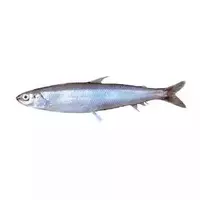Tulka fish

Quite often we acquire large fish, as it is believed that it contains less bones with a significant amount of meat lobe. Undoubtedly, this is so, but you should not ignore small varieties of fish, which, as a rule, are no less tasty and useful for our body. There are really a lot of bones in them, but during heat treatment they soften perfectly and become fully suitable for food.
The miniature fish with the funny name of the tulip deserves special attention. It belongs to small commercial marine species of fish from the herring family. With a maximum body length of 9 centimeters, the mass of tulip fish hardly exceeds 10 grams. Interestingly, this fish reaches puberty already at five centimeters in length, while the life expectancy of the tulip is about 4-5 years.
The habitat of tulip fish is the Sea of Azov, although it can often be found in the water area of the Northern and desalinated parts of the Black Sea. The spawning of tulip fish takes place mainly in May, but in the Black Sea this happens a month or later.
The fishing industry every year increases the already fast pace of fish extraction, thereby expanding the range of goods. It is noteworthy that a significant place among such products is also occupied by tulip fish products. The food industry supplies not only chilled, ice cream, salted and smoked tulips, but also delicately canned food and preserves from this sea fish.
Hostesses are also very fond of this small fish and quite often use a tulip to prepare a variety of delicious meals. The easiest way to process tulip fish is considered to be breading and frying in vegetable oil. In addition, you can easily prepare homemade canned food from tulips, for example, in oil or tomato sauce. The calorie content of the tulip is small and amounts to about 88 kcal per hundred grams of fresh fish.
The benefits of tulka
The benefits of tulka (like most marine fish) for the human body are the high content of phosphorus, calcium and iodine, as well as other nutrients. Small bones of tulips when cooked or salted soften well, so they are perfectly absorbed by the body. It is known that in the tails and bones of the tulip there are much more of these elements than, for example, in sturgeon.
In addition, the benefits of tulip are obvious due to the content of a whole set of amino acids vital for humans, of which there are 23 names in it. Especially these elements are necessary for women and elderly people, but it is important to consume such fish entirely.
tulip fish 88 kCal
Energy value of tulip fish (Ratio of proteins, fats, carbohydrates - ju):
Proteins: 17.5 (~ 70 kCal)
Fats: 2g (~ 18kCal)
Carbohydrates: 0 g (~ 0 kCal)
Energy ratio (b | y): 80% | 20% | 0%
 Español
Español Français
Français Português
Português Русский
Русский 简体中文
简体中文 繁體中文
繁體中文 日本語
日本語 한국어
한국어 العربية
العربية Türkçe
Türkçe Қазақ
Қазақ Deutsch
Deutsch Italiano
Italiano Українська
Українська
